cruise control TOYOTA HIGHLANDER 2013 XU50 / 3.G Owners Manual
[x] Cancel search | Manufacturer: TOYOTA, Model Year: 2013, Model line: HIGHLANDER, Model: TOYOTA HIGHLANDER 2013 XU50 / 3.GPages: 684, PDF Size: 15.42 MB
Page 3 of 684
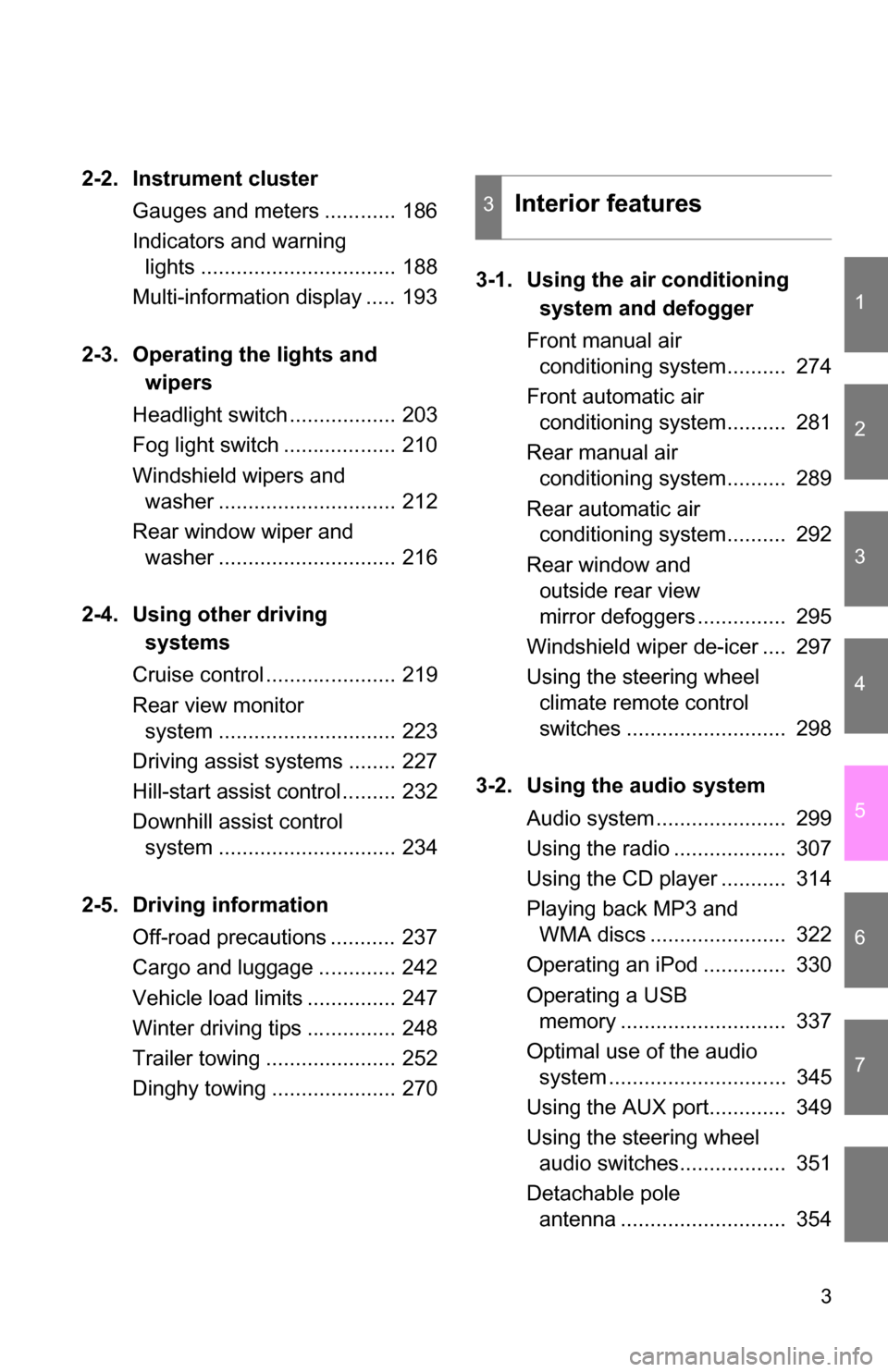
1
2
3
4
5
6
7
3
2-2. Instrument clusterGauges and meters ............ 186
Indicators and warning lights ................................. 188
Multi-information display ..... 193
2-3. Operating the lights and wipers
Headlight switch .................. 203
Fog light switch ................... 210
Windshield wipers and washer .............................. 212
Rear window wiper and washer .............................. 216
2-4. Using other driving systems
Cruise control ...................... 219
Rear view monitor system .............................. 223
Driving assist systems ........ 227
Hill-start assist control ......... 232
Downhill assist control system .............................. 234
2-5. Driving information Off-road precautions ........... 237
Cargo and luggage ............. 242
Vehicle load limits ............... 247
Winter driving tips ............... 248
Trailer towing ...................... 252
Dinghy towing ..................... 270 3-1. Using the air conditioning
system and defogger
Front manual air conditioning system.......... 274
Front automatic air conditioning system.......... 281
Rear manual air conditioning system.......... 289
Rear automatic air conditioning system.......... 292
Rear window and outside rear view
mirror defoggers ............... 295
Windshield wiper de-icer .... 297
Using the steering wheel climate remote control
switches ........................... 298
3-2. Using the audio system Audio system ...................... 299
Using the radio ................... 307
Using the CD player ........... 314
Playing back MP3 and WMA discs ....................... 322
Operating an iPod .............. 330
Operating a USB memory ............................ 337
Optimal use of the audio system .............................. 345
Using the AUX port............. 349
Using the steering wheel audio switches.................. 351
Detachable pole antenna ............................ 354
3Interior features
Page 18 of 684
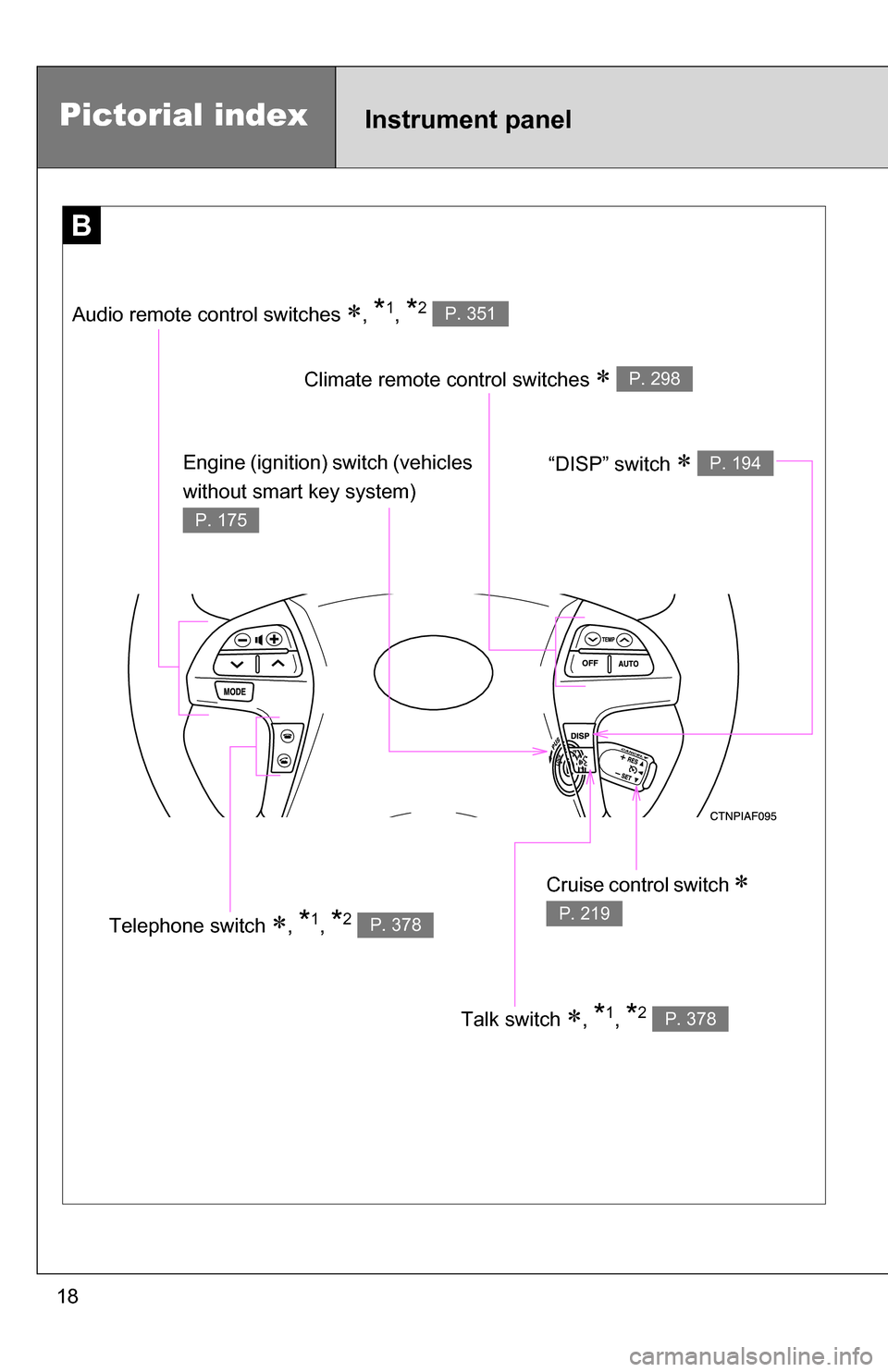
18
B
Talk switch , *1, *2 P. 378
Pictorial indexInstrument panel
Audio remote control switches , *1, *2 P. 351
Climate remote control switches P. 298
Cruise control switch
P. 219Telephone switch , *1, *2 P. 378
Engine (ignition) switch (vehicles
without smart key system)
P. 175
“DISP” switch P. 194
Page 26 of 684
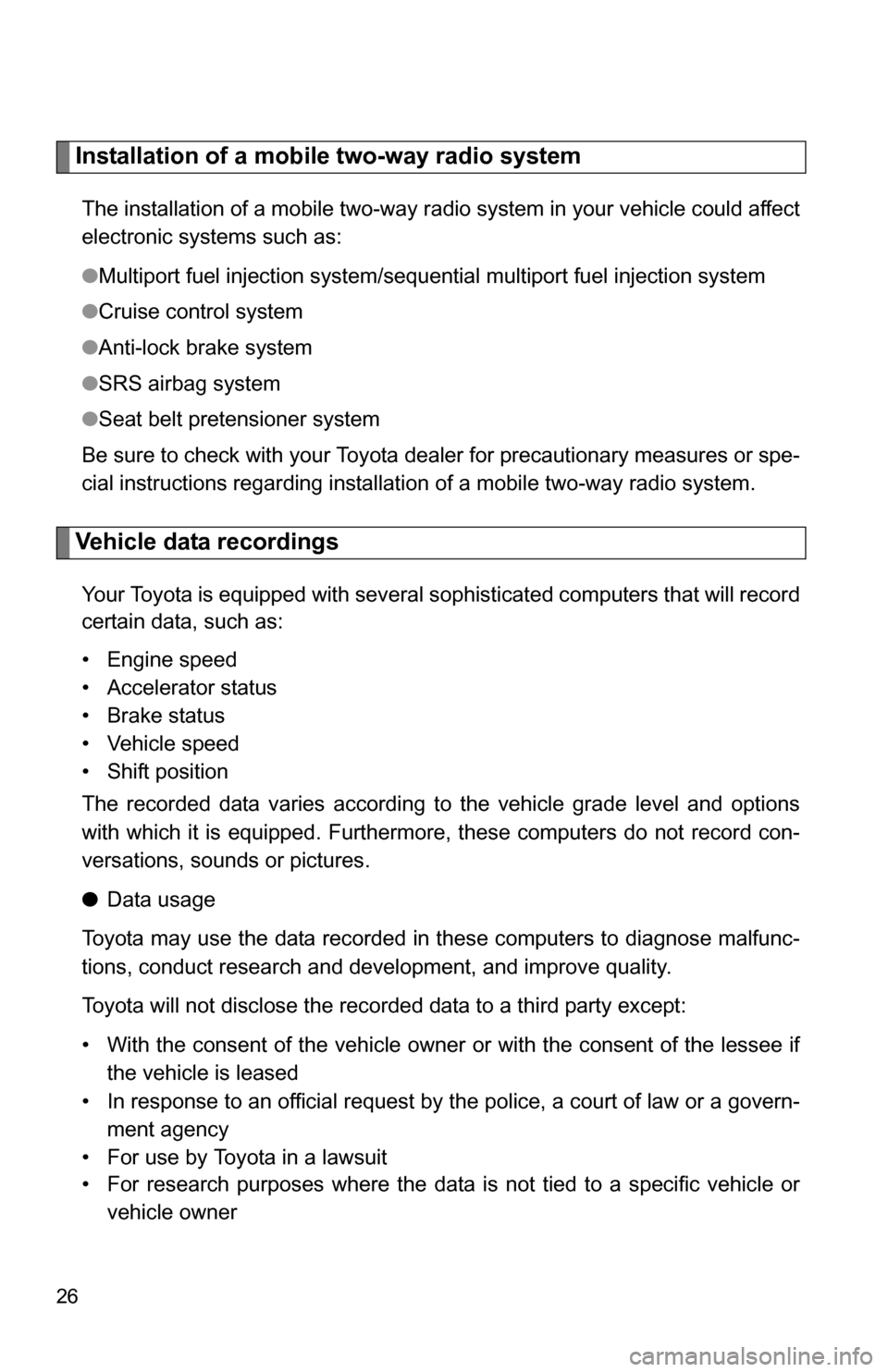
26
Installation of a mobile two-way radio system
The installation of a mobile two-way radio system in your vehicle could affect
electronic systems such as:
●Multiport fuel injection system/sequential multiport fuel injection system
●Cruise control system
●Anti-lock brake system
●SRS airbag system
●Seat belt pretensioner system
Be sure to check with your Toyota dealer for precautionary measures or spe-
cial instructions regarding installation of a mobile two-way radio system.
Vehicle data recordings
Your Toyota is equipped with several sophisticated computers that will record
certain data, such as:
• Engine speed
• Accelerator status
• Brake status
• Vehicle speed
• Shift position
The recorded data varies according to the vehicle grade level and options
with which it is equipped. Furthermore, these computers do not record con-
versations, sounds or pictures.
●Data usage
Toyota may use the data recorded in these computers to diagnose malfunc-
tions, conduct research and development, and improve quality.
Toyota will not disclose the recorded data to a third party except:
• With the consent of the vehicle owner or with the consent of the lessee if the vehicle is leased
• In response to an official request by the police, a court of law or a govern- ment agency
• For use by Toyota in a lawsuit
• For research purposes where the data is not tied to a specific vehicle or
vehicle owner
Page 159 of 684
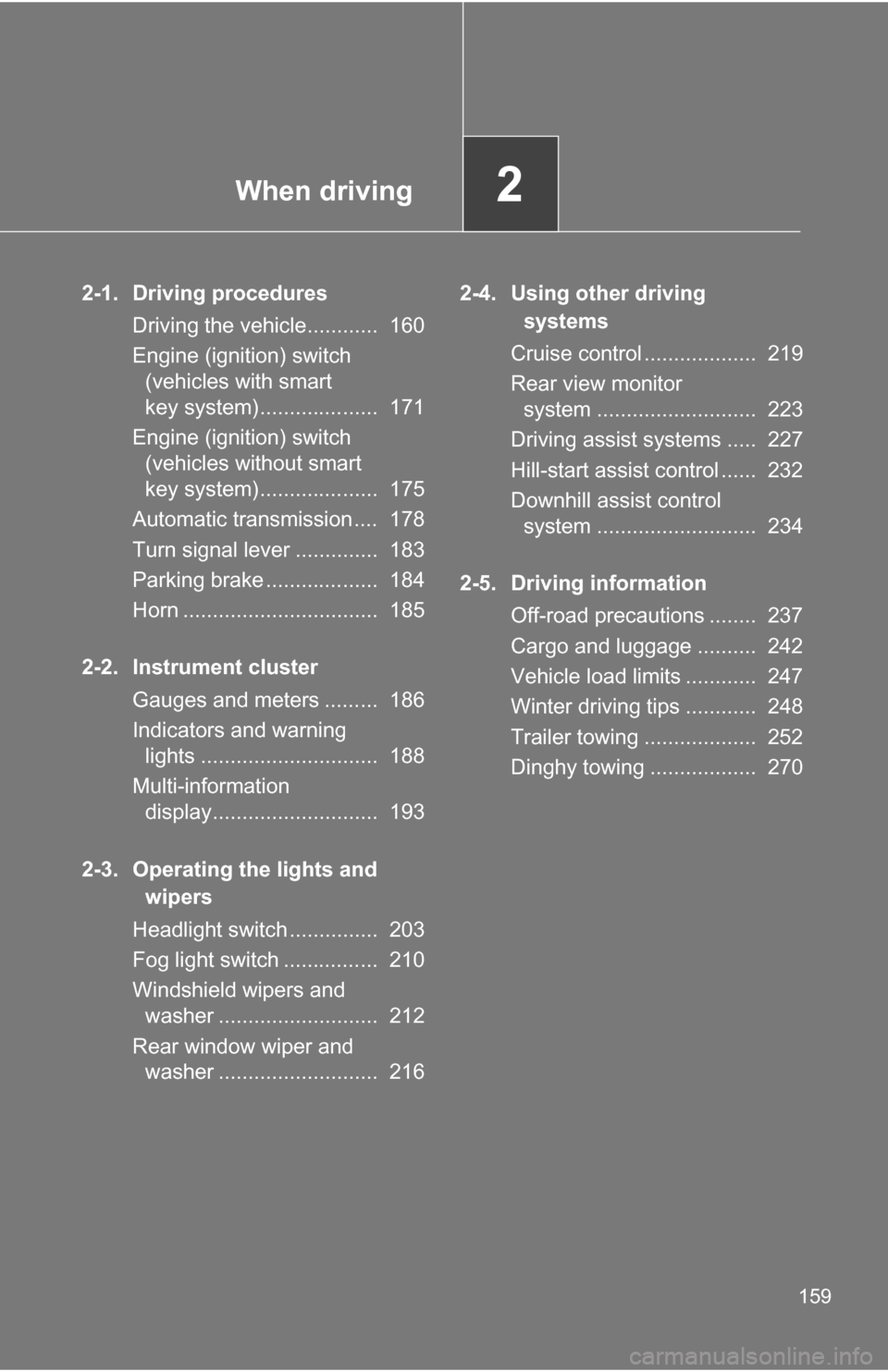
When driving2
159
2-1. Driving proceduresDriving the vehicle............ 160
Engine (ignition) switch (vehicles with smart
key system).................... 171
Engine (ignition) switch (vehicles without smart
key system).................... 175
Automatic transmission .... 178
Turn signal lever .............. 183
Parking brake ................... 184
Horn ................................. 185
2-2. Instrument cluster Gauges and meters ......... 186
Indicators and warning lights .............................. 188
Multi-information display............................ 193
2-3. Operating the lights and wipers
Headlight switch ............... 203
Fog light switch ................ 210
Windshield wipers and washer ........................... 212
Rear window wiper and washer ........................... 216 2-4. Using other driving
systems
Cruise control ................... 219
Rear view monitor system ........................... 223
Driving assist systems ..... 227
Hill-start assist control ...... 232
Downhill assist control system ........................... 234
2-5. Driving information Off-road precautions ........ 237
Cargo and luggage .......... 242
Vehicle load limits ............ 247
Winter driving tips ............ 248
Trailer towing ................... 252
Dinghy towing .................. 270
Page 181 of 684
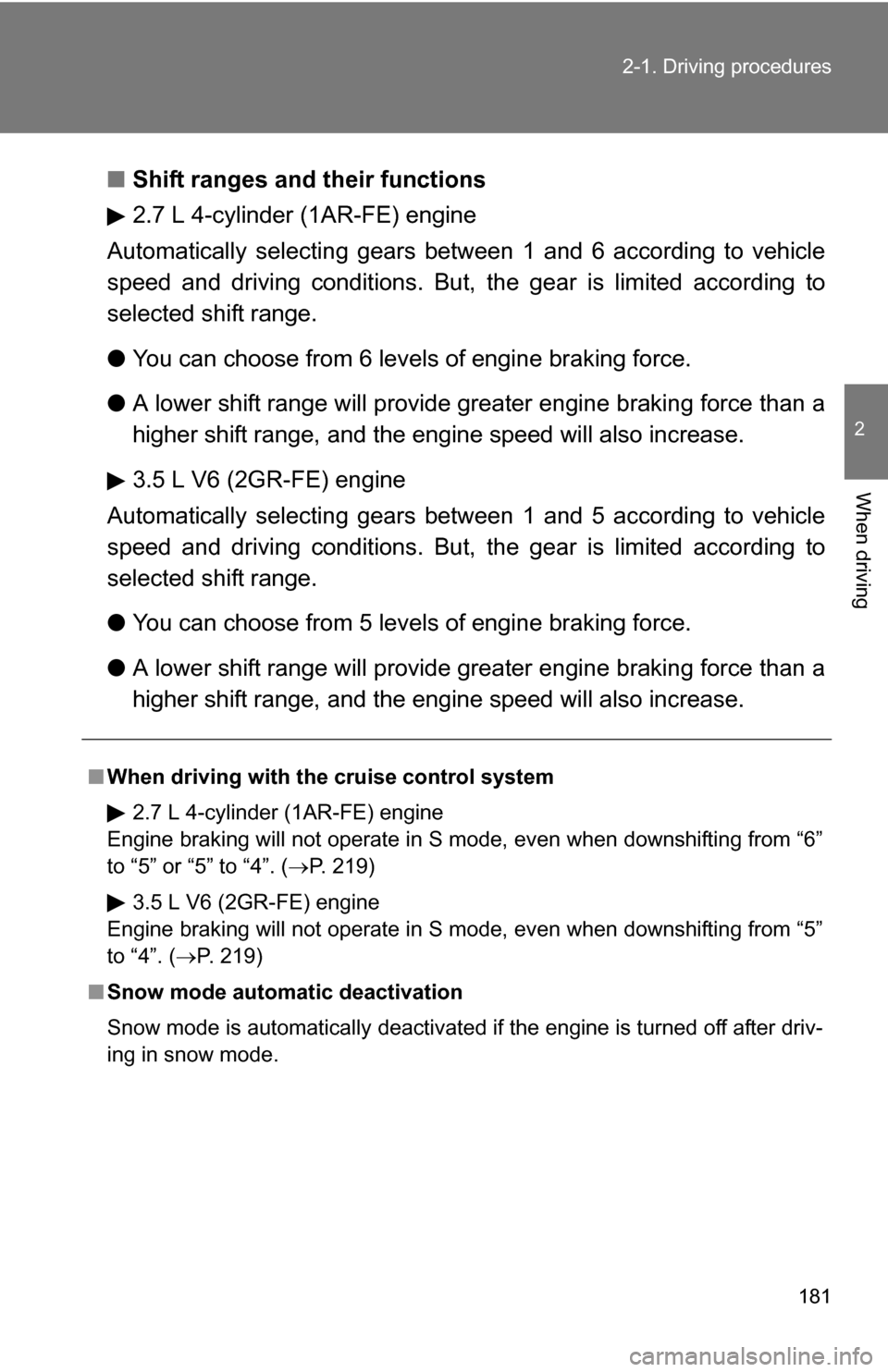
181
2-1. Driving procedures
2
When driving
■
Shift ranges and their functions
2.7 L 4-cylinder (1AR-FE) engine
Automatically selecting gears betwe en 1 and 6 according to vehicle
speed and driving conditions. But, the gear is limited according to
selected shift range.
● You can choose from 6 levels of engine braking force.
● A lower shift range will provide greater engine braking force than a
higher shift range, and the engine speed will also increase.
3.5 L V6 (2GR-FE) engine
Automatically selecting gears betwe en 1 and 5 according to vehicle
speed and driving conditions. But, the gear is limited according to
selected shift range.
● You can choose from 5 levels of engine braking force.
● A lower shift range will provide greater engine braking force than a
higher shift range, and the engine speed will also increase.
■When driving with the cruise control system
2.7 L 4-cylinder (1AR-FE) engine
Engine braking will not operate in S mode, even when downshifting from “6”
to “5” or “5” to “4”. ( P. 219)
3.5 L V6 (2GR-FE) engine
Engine braking will not operate in S mode, even when downshifting from “5”
to “4”. ( P. 219)
■ Snow mode automatic deactivation
Snow mode is automatically deactivated if the engine is turned off after driv-
ing in snow mode.
Page 190 of 684
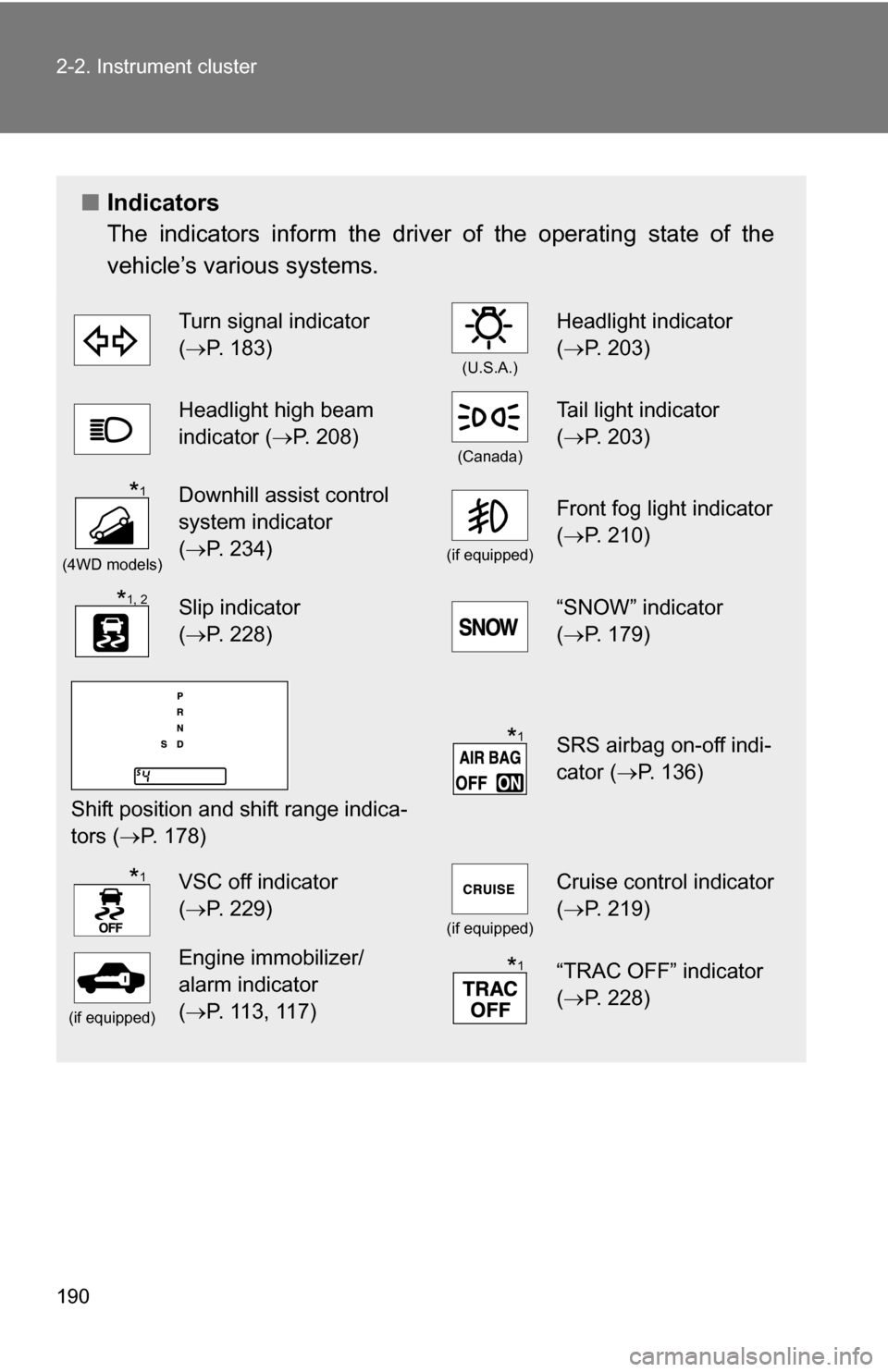
190 2-2. Instrument cluster
■Indicators
The indicators inform the driver of the operating state of the
vehicle’s various systems.
Turn signal indicator
(P. 183)
(U.S.A.)
Headlight indicator
( P. 203)
Headlight high beam
indicator ( P. 208)
(Canada)
Tail light indicator
(P. 203)
(4WD models)
Downhill assist control
system indicator
(P. 234)
(if equipped)
Front fog light indicator
( P. 210)
Slip indicator
(P. 228)“SNOW” indicator
( P. 179)
Shift position and shift range indica-
tors ( P. 178)
SRS airbag on-off indi-
cator (P. 136)
VSC off indicator
(P. 229)
(if equipped)
Cruise control indicator
( P. 219)
(if equipped)
Engine immobilizer/
alarm indicator
(P. 113, 117)“TRAC OFF” indicator
( P. 228)
*1
*1, 2
*1
*1
*1
Page 219 of 684

219
2
When driving
2-4. Using other driving systems
Cruise control
Use the cruise control to maintain a set speed without depressing
the accelerator pedal.
Indicator
Cruise control switch
■ Setting the vehicle speed
Press the “ON-OFF” button to
activate the cruise control.
Cruise control indicator will
come on.
Press the button again to
deactivate the cruise control.
Accelerate or decelerate the
vehicle to the desired speed,
and push the lever down to set
the speed.
The vehicle speed at the
moment the lever is released
becomes the set speed.
STEP1
STEP2
�
: If equipped
Page 221 of 684
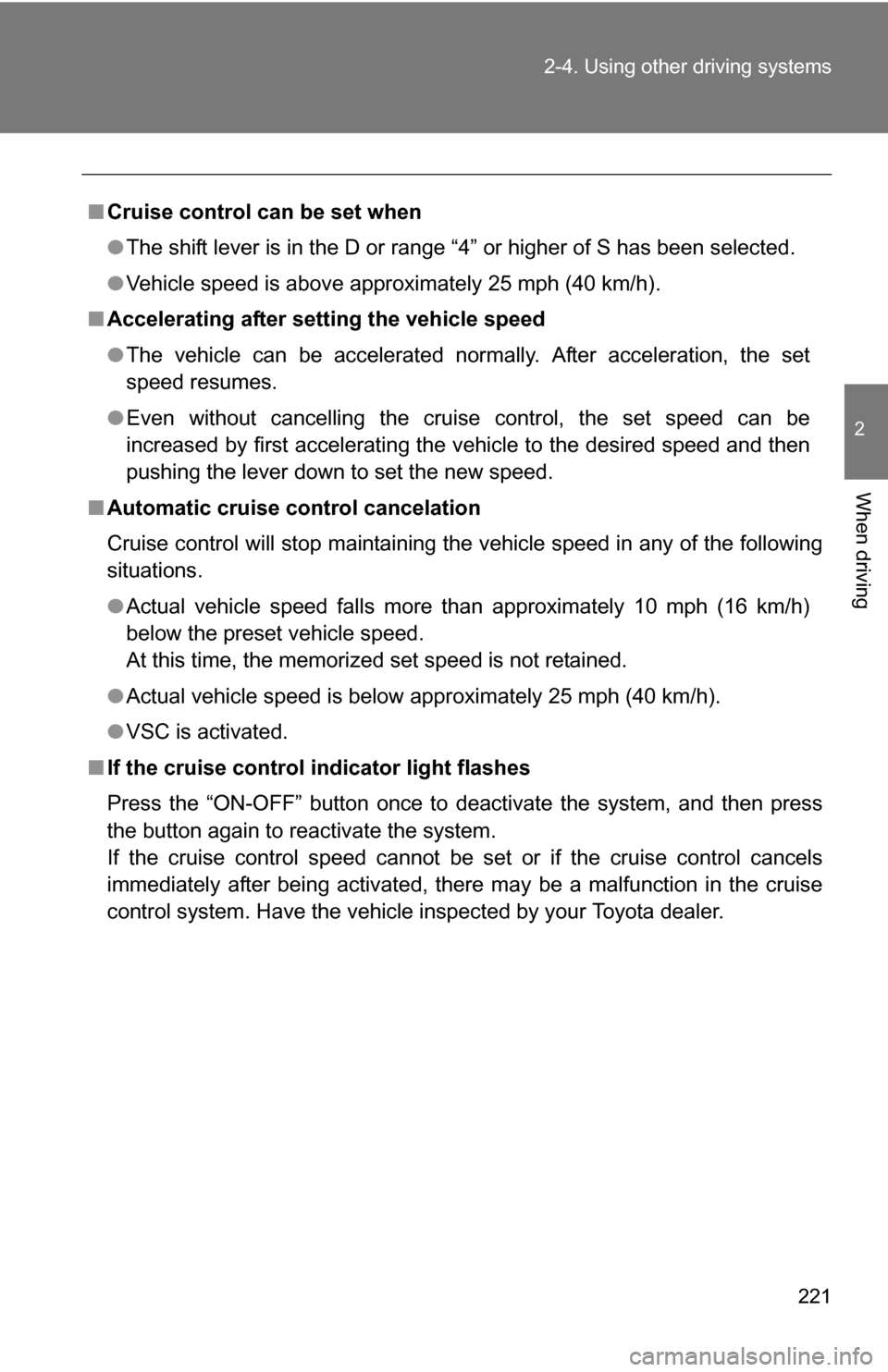
221
2-4. Using other
driving systems
2
When driving
■Cruise control can be set when
●The shift lever is in the D or range “4” or higher of S has been selected.
● Vehicle speed is above approximately 25 mph (40 km/h).
■ Accelerating after setting the vehicle speed
●The vehicle can be accelerated normally. After acceleration, the set
speed resumes.
● Even without cancelling the cruise control, the set speed can be
increased by first accelerating the vehicle to the desired speed and then
pushing the lever down to set the new speed.
■ Automatic cruise control cancelation
Cruise control will stop maintaining the vehicle speed in any of the following
situations.
●Actual vehicle speed falls more than approximately 10 mph (16 km/h)
below the preset vehicle speed.
At this time, the memorized set speed is not retained.
● Actual vehicle speed is below approximately 25 mph (40 km/h).
● VSC is activated.
■ If the cruise control indicator light flashes
Press the “ON-OFF” button once to deactivate the system, and then press
the button again to reactivate the system.
If the cruise control speed cannot be set or if the cruise control cancels
immediately after being activated, there may be a malfunction in the cruise
control system. Have the vehicle inspected by your Toyota dealer.
Page 222 of 684
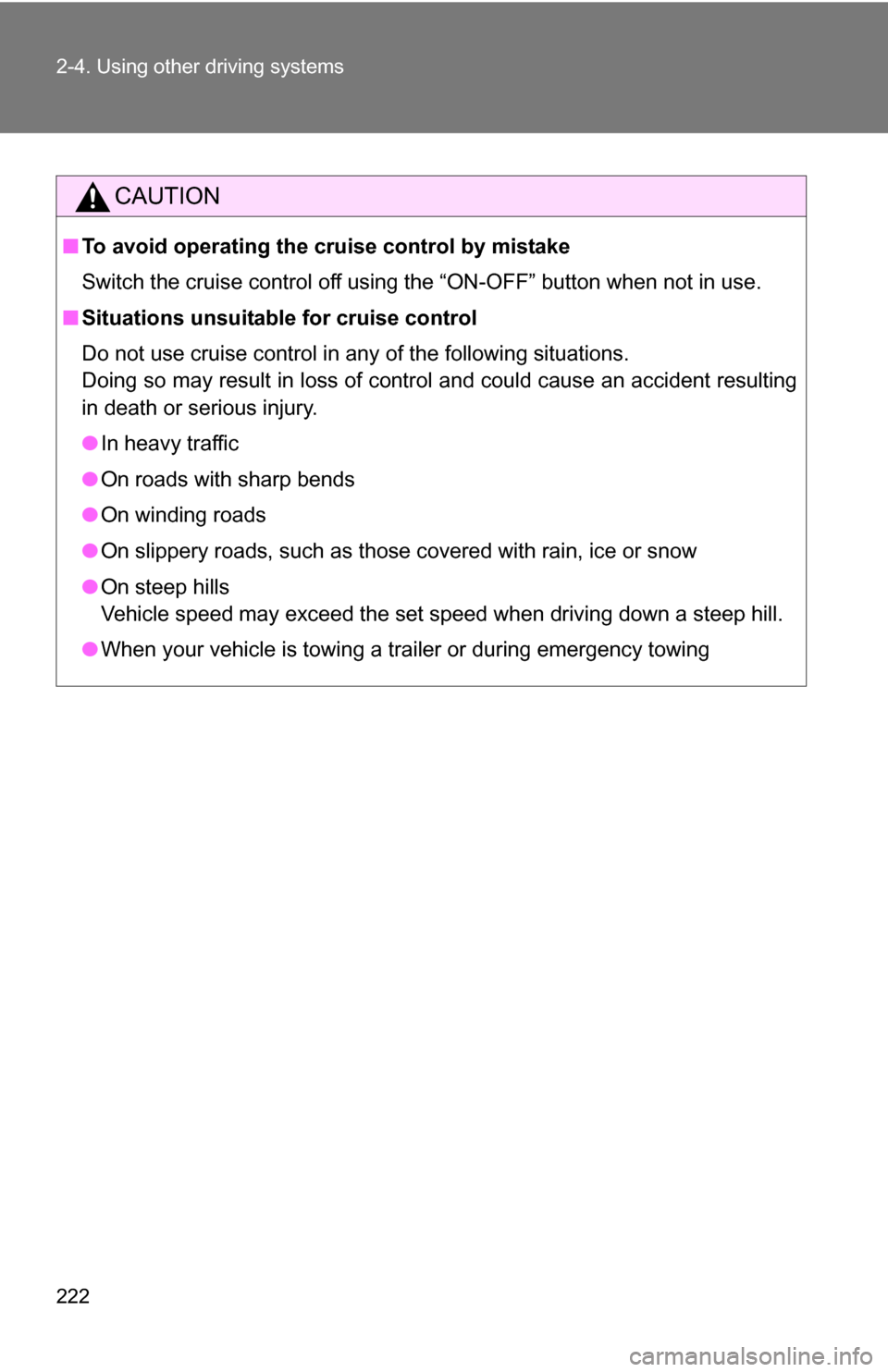
222 2-4. Using other driving systems
CAUTION
■To avoid operating the cruise control by mistake
Switch the cruise control off using the “ON-OFF” button when not in use.
■ Situations unsuitable for cruise control
Do not use cruise control in any of the following situations.
Doing so may result in loss of control and could cause an accident resulting
in death or serious injury.
●In heavy traffic
● On roads with sharp bends
● On winding roads
● On slippery roads, such as those covered with rain, ice or snow
● On steep hills
Vehicle speed may exceed the set speed when driving down a steep hill.
● When your vehicle is towing a trailer or during emergency towing
Page 267 of 684
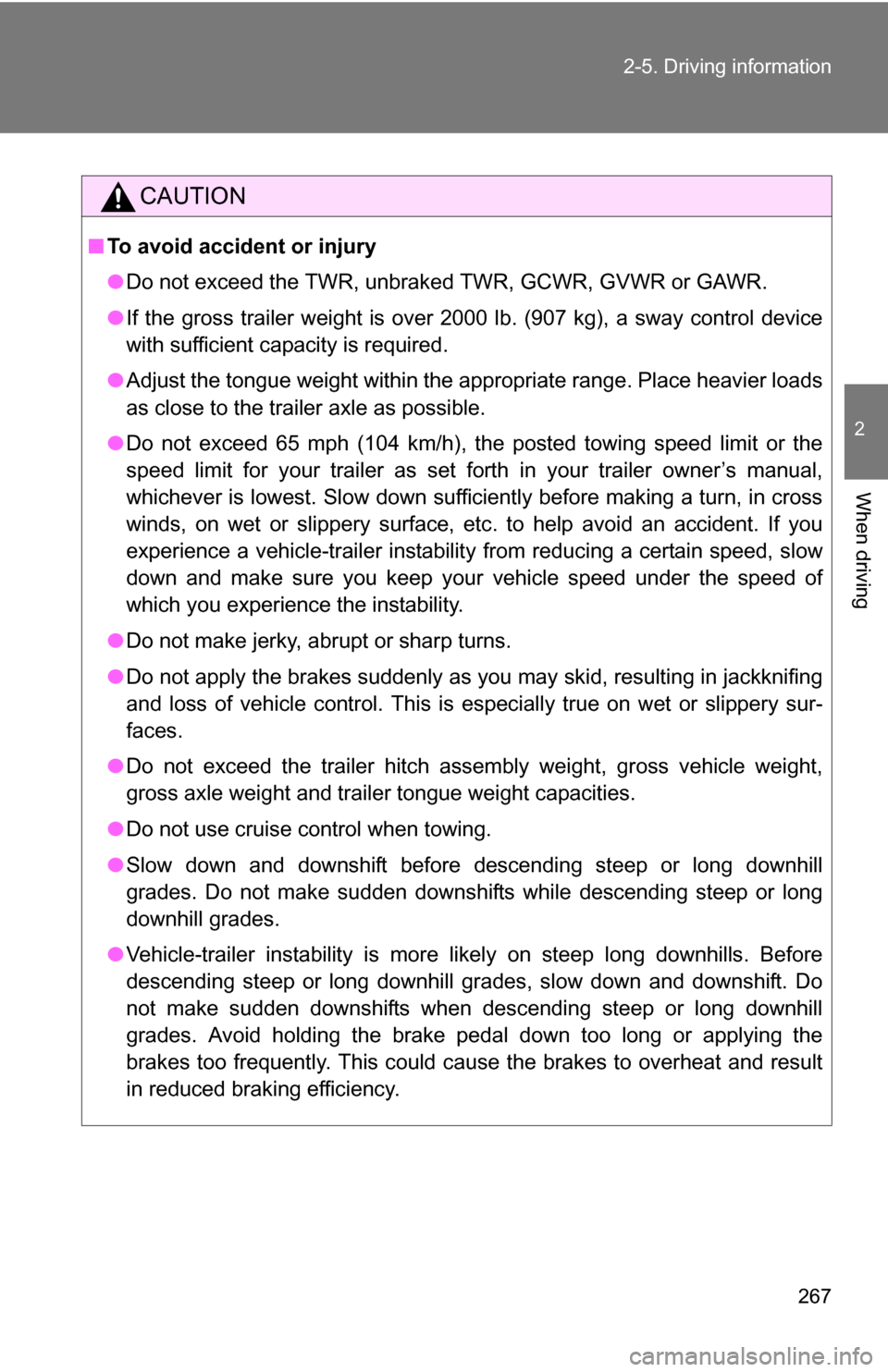
267
2-5. Driving information
2
When driving
CAUTION
■
To avoid accident or injury
●Do not exceed the TWR, unbraked TWR, GCWR, GVWR or GAWR.
● If the gross trailer weight is over 2000 lb. (907 kg), a sway control device
with sufficient capacity is required.
● Adjust the tongue weight within the appropriate range. Place heavier loads
as close to the trailer axle as possible.
● Do not exceed 65 mph (104 km/h), the posted towing speed limit or the
speed limit for your trailer as set forth in your trailer owner’s manual,
whichever is lowest. Slow down sufficiently before making a turn, in cross
winds, on wet or slippery surface, etc. to help avoid an accident. If you
experience a vehicle-trailer instabilit y from reducing a certain speed, slow
down and make sure you keep your vehicle speed under the speed of
which you experience the instability.
● Do not make jerky, abrupt or sharp turns.
● Do not apply the brakes suddenly as you may skid, resulting in jackknifing
and loss of vehicle control. This is especially true on wet or slippery sur-
faces.
● Do not exceed the trailer hitch assembly weight, gross vehicle weight,
gross axle weight and trailer tongue weight capacities.
● Do not use cruise control when towing.
● Slow down and downshift before descending steep or long downhill
grades. Do not make sudden downshifts while descending steep or long
downhill grades.
● Vehicle-trailer instability is more likely on steep long downhills. Before
descending steep or long downhill grades, slow down and downshift. Do
not make sudden downshifts when descending steep or long downhill
grades. Avoid holding the brake pedal down too long or applying the
brakes too frequently. This could cause the brakes to overheat and result
in reduced braking efficiency.